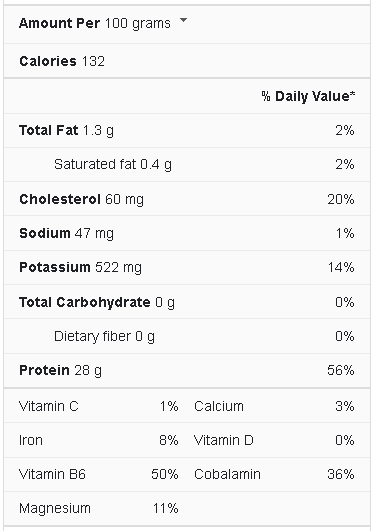Many individuals are hesitant to eat tuna because of concerns about mercury levels in fish. Although mercury should be considered for some groups, tuna also contains several health-promoting elements that should be included in your diet. Please continue reading to learn more about the nutritional costs and benefits of tuna and how to include it in a balanced diet. While tuna contains heart-healthy omega-3 fatty acids, mercury exposure is a big problem.
Vitamin B12, which is required to produce DNA, is abundant in tuna. Vitamin B12 also aids in the formation of new red blood cells and the prevention of anemia. According to the USDA National Nutrient Database, it also has high quantities of selenium, phosphorus, iron, magnesium, and potassium.
Tuna Nutrition Facts
What is Tuna?
Tuna is a saltwater fish that belongs to the Scombridae family, often known as the mackerel family. Tuna belongs to the Thunnini tribe within this family. This tribe has 15 tuna species, some of which are used in culinary traditions worldwide.
A fully mature, long-lived example of this fish species can range in length from 1 foot to 15 feet. While most fish live for three to five years, some have been known to live for almost two decades. Due to mating and changing seasons, they make extended migrations throughout the oceans, often thousands of miles long.
Tuna fish of various types may be found in every ocean on the planet, and while different civilizations appreciate different sorts, the health advantages are generally the same. They’re a perfect replacement for red meat or for individuals who want to add some nutritious fish variety to their meals because of their delicious taste, global availability, and healthful components. However, several tuna species are endangered and should be avoided. Search for tuna with the Marine Stewardship Council’s blue MSC badge if you care about the environment.
What are the Health Benefits of Tuna?
Whether you have it fresh or canned, tuna has several health benefits. Here are a few ways tuna might support your health.
Helps Prevent Anemia
Tuna is high in folate, iron, and vitamin B12. Anemia can be caused by a lack of one or more of these micronutrients. Anemia can cause muscle weakness, blurred vision, excessive exhaustion, and a variety of more significant consequences, such as infertility. Tuna contributes to a healthy nutritional foundation for preventing anemia caused by nutritional deficits.
Promotes Heart Health
DHA and EPA, two heart-healthy omega-3 fatty acids, are found in tuna. Fish oil supplements derived from tuna have been demonstrated to decrease triglycerides while increasing other forms of cholesterol. These findings imply that eating tuna or taking fish oil supplements can help minimize the risk of heart disease.
May Reduce Risk of Dementia
Memory, behavior, and cognitive function are affected by strokes and other vascular brain injuries. We can help prevent the progression of dementia by balancing our omega-6 fatty acid diet with increased omega-3 fatty acid intake (from seafood like tuna). Tuna’s omega-3 fatty acids compete with pro-inflammatory omega-6 fatty acids to inhibit inflammation at the cellular level, reducing the risk of vascular cognitive impairment and dementia.
Counters Age-Related Muscle Loss (Sarcopenia)
In older adults, higher polyunsaturated fat consumption from foods like tuna is linked to increased lean body mass and grip strength. Furthermore, necessary amino acids (found in tuna) promote muscle protein synthesis and help maintain muscle mass despite aging. Tuna’s combination of fatty acids and protein can help you stay robust as you get older.
Supports Blood Sugar Control
Tuna is carbohydrate-free and rich in nutrients that help with diabetic management. Fish strong in omega-3s, such as albacore tuna, are among the top ten superfoods, according to the American Diabetes Association. According to the experts, fish should be eaten twice a week to help manage diabetes.
What are the Side Effects of Eating Tuna?
Tuna fish accumulate toxic mercury in their flesh. Mercury has no odor and is completely undetectable by humans. However, once in the body, it can operate as a neurotoxin, causing disruptions in the brain and neurological system. Mercury poisoning is particularly dangerous for young children and pregnant women.
A child’s brain absorbs nutrients at a fast rate as it develops. Mercury can cause learning problems and developmental delays by interfering with this process. High doses can cause cognitive problems, cerebral palsy, deafness, and blindness in newborns and fetuses. Mercury toxicity in adults has been linked to fertility and blood pressure control problems.
Mercury poisoning can also cause the following symptoms:
- Memory loss
- Tremors
- Vision loss
- Numbness of extremities
How Often Should I Eat Tuna?
Tuna is exceptionally nutritious, including high protein levels, good fats, and vitamins, but it should not be consumed daily. Adults should eat 3–5 ounces (85–140 grams) of fish 2–3 times a week, according to the FDA, to get enough omega-3 fatty acids and other beneficial nutrients. However, studies show that eating fish with a mercury concentration of more than 0.3 ppm regularly can raise blood mercury levels and cause health problems. The majority of tuna species exceed this limit. As a result, most adults should eat tuna in moderation and choose a mercury-free fish.
Varieties
Tuna is available in both fresh and tinned form. Tuna steaks, frozen fillets, and sushi and sashimi are all options for fresh tuna. Tuna is canned in either water or oil. Commercially, five species are most usually sold.
Albacore tuna is the white flesh tuna kind. Skipjack tuna is commonly referred to as “light” tuna. Yellowfin tuna is often blended with skipjack tuna in light tuna cans, but it’s more commonly marketed as “ahi tuna” steaks. Bigeye tuna is popular in sushi and sashimi. Bluefin tuna is the most costly type of tuna, and sushi and sashimi are the only ways to eat bluefin tuna.
Storage and Food Safety
If you’re buying fresh fish, steer clear of anything that smells fishy, sour, or ammonia-like. The flesh of fresh tuna should be red and solid. Check if the fish was stored at the right temperature if indicators are present. Although fresh fish may be labeled “previously frozen,” it should always smell fresh. Frozen fish should be substantial and not pliable.
After purchasing raw tuna, immediately place it on ice or in the refrigerator and utilize it within two days. Wrap it tightly in plastic wrap and foil and freeze it if you don’t plan to use it immediately. After handling raw seafood, wash your hands thoroughly with soapy water for 20 seconds. After preparing raw fish, clean the counters, cutting boards, and utensils.
Thaw frozen fish in the refrigerator or cold water in a tight plastic bag. Raw tuna should be cooked to a temperature of 145 degrees Fahrenheit. If you’re going to consume raw or undercooked tuna, look for products that have been frozen before, as they’re less likely to carry parasites.
If the container is sealed, unopened canned or pouch tuna can be preserved for several years. Try to consume the goods within a year after purchase for the optimum quality. Place previously canned tuna in a sealed container and store in the refrigerator after opening. Within 3–4 days, use. After opening a can of tuna, put it in an airtight container in the freezer.
Conclusion
Tuna is a popular fish that is commonly consumed. On the other hand, Canned tuna is frequently the most prevalent source of mercury in the diet. The term tuna refers to various fish species, including skipjack, albacore, yellowfin, and bigeye tuna. The most popular species to eat is skipjack. Tuna is a saltwater fish that is widely consumed around the world.
It’s high in protein, omega-3 fatty acids, and B vitamins and is relatively healthy. It may, however, contain significant quantities of mercury, a hazardous heavy metal. Mercury is released into the sky or straight into the ocean by natural processes such as volcanic eruptions and industrial activity such as coal burning, where it accumulates in marine life. Too much mercury in the diet has been linked to significant health problems, prompting worries about regular tuna consumption.



